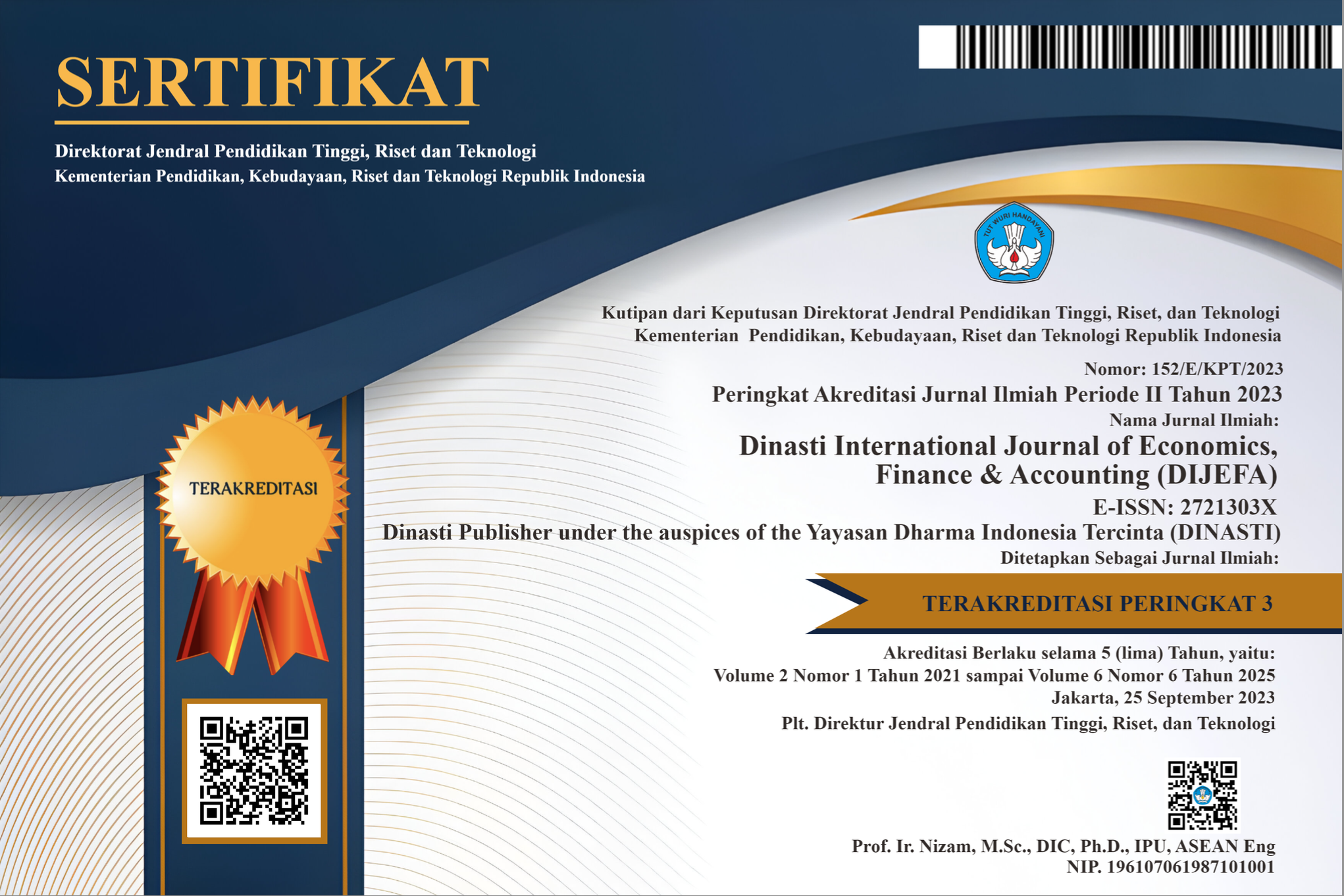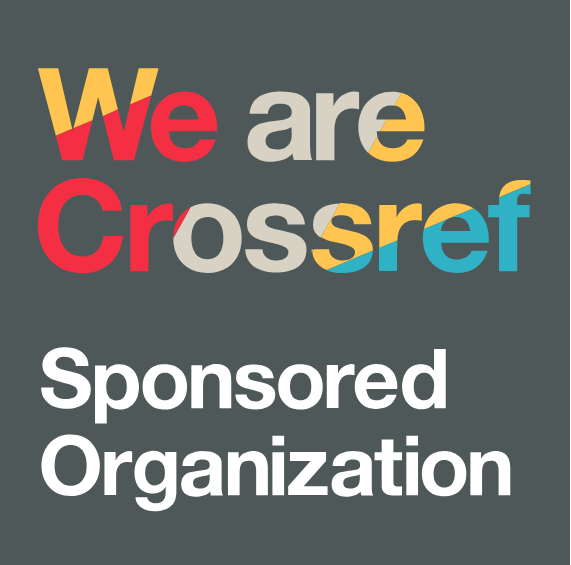Assessing the Mediating Role of Competitive Advantage: The Influence of Innovation Capabilities and Strategic Flexibility on Firm Performance in East Java’s F&B Industry Post COVID-19
DOI:
https://doi.org/10.38035/dijefa.v6i1.4004Keywords:
Innovation Capabilities, Strategic Flexibility, Competitive Advantage, Firm Performance, East Java SMEsAbstract
This study investigates the mediating role of competitive advantage in the innovation capability and strategic flexibility-firm performance link, in regard to the food and beverage SMEs of East Java, post-COVID-19. This research will seek to explain how these two factors contribute to firm performance by having competitive advantage as a mediating variable. Data were collected from 107 respondents who underwent quantitative analysis. The results showed that innovation capability significantly and directly affects competitive advantage and firm performance, while strategic flexibility affects firm performance only significantly through the mediation of competitive advantage, noting its indirect role. Again, this research points to the enhancement of innovation capabilities as an important way to sustain competitive advantages; hence, a recommendation goes to SMEs in East Java for strategizing to become adaptable. The findings form a helpful indication for the SME managers on how to develop long-term performance in the dynamic business environment.
References
Anwar, M., Rehman, A. U., & Shah, S. Z. A. (2018). Networking and new venture’s performance: mediating role of competitive advantage. International Journal of Emerging Markets, 13(5), 998–1025. https://doi.org/10.1108/IJoEM-07-2017-0263
Bashir, M. (2023). The influence of strategic flexibility on SME performance: is business model innovation the missing link? International Journal of Innovation Science, 15(5), 799–816. https://doi.org/10.1108/IJIS-06-2021-0110
Brozovi?, D., Jansson, C., & Boers, B. (2023). Strategic flexibility and growth of small and medium-sized enterprises: a study of enablers and barriers. Management Decision. https://doi.org/10.1108/MD-05-2022-0577
Brydges, C. R. (2019). Effect Size Guidelines, Sample Size Calculations, and Statistical Power in Gerontology. Innovation in Aging, 3(4). https://doi.org/10.1093/geroni/igz036
Bujang, M. A., Omar, E. D., & Baharum, N. A. (2018). A Review on Sample Size Determination for Cronbach’s Alpha Test: A Simple Guide for Researchers. Malaysian Journal of Medical Sciences, 25(6), 85–99. https://doi.org/10.21315/mjms2018.25.6.9
Campbell, S., Greenwood, M., Prior, S., Shearer, T., Walkem, K., Young, S., Bywaters, D., & Walker, K. (2020). Purposive sampling: complex or simple? Research case examples. Journal of Research in Nursing, 25(8), 652–661. https://doi.org/10.1177/1744987120927206
Chan, A. T. L., Ngai, E. W. T., & Moon, K. K. L. (2017). The effects of strategic and manufacturing flexibilities and supply chain agility on firm performance in the fashion industry. European Journal of Operational Research, 259(2), 486–499. https://doi.org/10.1016/j.ejor.2016.11.006
Cheung, G. W., Cooper-Thomas, H. D., Lau, R. S., & Wang, L. C. (2024). Reporting reliability, convergent and discriminant validity with structural equation modeling: A review and best-practice recommendations. Asia Pacific Journal of Management, 41(2), 745–783. https://doi.org/10.1007/s10490-023-09871-y
Chicco, D., Warrens, M. J., & Jurman, G. (2021). The coefficient of determination R-squared is more informative than SMAPE, MAE, MAPE, MSE and RMSE in regression analysis evaluation. PeerJ Computer Science, 7, e623. https://doi.org/10.7717/peerj-cs.623
Chowdhury, M. T., Sarkar, A., Paul, S. K., & Moktadir, M. A. (2022). A case study on strategies to deal with the impacts of COVID-19 pandemic in the food and beverage industry. Operations Management Research, 15(1–2), 166–178. https://doi.org/10.1007/s12063-020-00166-9
De Sordi, J. O., Paulo, W. L. de, Santos, A. R. dos R., Nelson, R. E., de Azevedo, M. C., Hashimoto, M., & Cavallari Filho, R. (2024). Small businesses are not necessarily “small and medium-sized enterprises.” Journal of Small Business and Enterprise Development, 31(1), 1–30. https://doi.org/10.1108/JSBED-03-2023-0135
Exposito, A., & Sanchis-Llopis, J. A. (2018). Innovation and business performance for Spanish SMEs: New evidence from a multi-dimensional approach. International Small Business Journal: Researching Entrepreneurship, 36(8), 911–931. https://doi.org/10.1177/0266242618782596
Expósito, A., & Sanchis-Llopis, J. A. (2019). The relationship between types of innovation and SMEs’ performance: a multi-dimensional empirical assessment. Eurasian Business Review, 9(2), 115–135. https://doi.org/10.1007/s40821-018-00116-3
Ferreira, J., Cardim, S., & Coelho, A. (2021). Dynamic Capabilities and Mediating Effects of Innovation on the Competitive Advantage and Firm’s Performance: the Moderating Role of Organizational Learning Capability. Journal of the Knowledge Economy, 12(2), 620–644. https://doi.org/10.1007/s13132-020-00655-z
Guan, J., & Ma, N. (2003). Innovative capability and export performance of Chinese firms. Technovation, 23(9), 737–747. https://doi.org/10.1016/S0166-4972(02)00013-5
Gyedu, S., Tang, H., Ntarmah, A. H., & Manu, E. K. (2021). The moderating effect of environmental turbulence on the relationship between innovation capability and business performance. International Journal of Innovation Science, 13(4), 456–476. https://doi.org/10.1108/IJIS-10-2020-0189
Hair, J. F., Hult, G. T. M., Ringle, C. M., Sarstedt, M., Danks, N. P., & Ray, S. (2021a). An Introduction to Structural Equation Modeling (pp. 1–29). https://doi.org/10.1007/978-3-030-80519-7_1
Hair, J. F., Hult, G. T. M., Ringle, C. M., Sarstedt, M., Danks, N. P., & Ray, S. (2021b). Evaluation of the Structural Model (pp. 115–138). https://doi.org/10.1007/978-3-030-80519-7_6
Hair, J. F., Hult, G. T. M., Ringle, C. M., Sarstedt, M., Danks, N. P., & Ray, S. (2021c). Partial Least Squares Structural Equation Modeling (PLS-SEM) Using R. Springer International Publishing. https://doi.org/10.1007/978-3-030-80519-7
Haq, M., & Davies, J. (2023). “The person with maximum knowledge will win the race”: Conceptualizing knowledge in microbusinesses. Journal of Small Business Management, 61(2), 295–321. https://doi.org/10.1080/00472778.2020.1768799
Helfat, C. E., & Peteraf, M. A. (2009). Understanding dynamic capabilities: progress along a developmental path. Strategic Organization, 7(1), 91–102. https://doi.org/10.1177/1476127008100133
Herhausen, D., Morgan, R. E., Brozovi?, D., & Volberda, H. W. (2021). Re?examining Strategic Flexibility: A Meta?Analysis of its Antecedents, Consequences and Contingencies. British Journal of Management, 32(2), 435–455. https://doi.org/10.1111/1467-8551.12413
Hidayah, I. N., Rohmah, N. F., & Saifuddin, M. (2021). Effectiveness of Digital Platforms as Food and Beverage Marketing Media during the COVID-19 Pandemic. Airlangga Journal of Innovation Management, 2(2), 122. https://doi.org/10.20473/ajim.v2i2.30696
Jafari, H., Ghaderi, H., Malik, M., & Bernardes, E. (2023). The effects of supply chain flexibility on customer responsiveness: the moderating role of innovation orientation. Production Planning & Control, 34(16), 1543–1561. https://doi.org/10.1080/09537287.2022.2028030
Jalil, M. F., Ali, A., & Kamarulzaman, R. (2022). Does innovation capability improve SME performance in Malaysia? The mediating effect of technology adoption. The International Journal of Entrepreneurship and Innovation, 23(4), 253–267. https://doi.org/10.1177/14657503211048967
Josua Pardede, A. H. (2023). Indonesia Food and beverage Industry. https://www.permatabank.com/sites/default/files/Monthly Industry Report - Food and Beverages Industry - Aug 23_1.pdf
Junaedi. (2023). Digital Culture Revolution in Improving Firm Performance in Indonesia. Journal of System and Management Sciences, 14(1). https://doi.org/10.33168/JSMS.2024.0126
Kafetzopoulos, P., Psomas, E., & Katou, A. A. (2023). Promoting Strategic Flexibility and Business Performance through Organizational Ambidexterity. Sustainability, 15(17), 12997. https://doi.org/10.3390/su151712997
Kiyabo, K., & Isaga, N. (2019). Strategic entrepreneurship, competitive advantage, and SMEs’ performance in the welding industry in Tanzania. Journal of Global Entrepreneurship Research, 9(1), 62. https://doi.org/10.1186/s40497-019-0188-9
Kock, N. (2016). Hypothesis Testing with Confidence Intervals and P Values in PLS-SEM. International Journal of E-Collaboration, 12(3), 1–6. https://doi.org/10.4018/IJeC.2016070101
Macfarlane, S. B. J. (1996). Conducting a Descriptive Survey: 1. Planning the Survey. Tropical Doctor, 26(4), 161–164. https://doi.org/10.1177/004947559602600407
Magno, F., Cassia, F., & Ringle, C. M. (2024). A brief review of partial least squares structural equation modeling (PLS-SEM) use in quality management studies. The TQM Journal, 36(5), 1242–1251. https://doi.org/10.1108/TQM-06-2022-0197
McCrae, N., & Purssell, E. (2015). Eligibility criteria in systematic reviews published in prominent medical journals: a methodological review. Journal of Evaluation in Clinical Practice, 21(6), 1052–1058. https://doi.org/10.1111/jep.12448
Méndez-Suárez, M. (2021). Marketing Mix Modeling Using PLS-SEM, Bootstrapping the Model Coefficients. Mathematics, 9(15), 1832. https://doi.org/10.3390/math9151832
Nadkarni, S., & Herrmann, P. (2010). CEO Personality, Strategic Flexibility, and Firm Performance: The Case of the Indian Business Process Outsourcing Industry. Academy of Management Journal, 53(5), 1050–1073. https://doi.org/10.5465/amj.2010.54533196
Otache, I., & Usang, O. U. E. (2022). Innovation capability and SME performance in times of economic crisis: does government support moderate? African Journal of Economic and Management Studies, 13(1), 76–88. https://doi.org/10.1108/AJEMS-08-2021-0362
Quintero Sepúlveda, I. C., & Zúñiga Collazos, A. (2025). Innovation capabilities, innovation strategies and performance: an empirical analysis in SMEs. Technology Analysis & Strategic Management, 37(1), 19–34. https://doi.org/10.1080/09537325.2023.2280523
Safari, A., Adelpanah, A., Soleimani, R., Heidari Aqagoli, P., Eidizadeh, R., & Salehzadeh, R. (2020). The effect of psychological empowerment on job burnout and competitive advantage. Management Research: Journal of the Iberoamerican Academy of Management, 18(1), 47–71. https://doi.org/10.1108/MRJIAM-06-2019-0935
Sanchez, R. (1995). Strategic flexibility in product competition. Strategic Management Journal, 16(S1), 135–159. https://doi.org/10.1002/smj.4250160921
Saunila, M. (2017). Innovation capability in achieving higher performance: perspectives of management and employees. Technology Analysis & Strategic Management, 29(8), 903–916. https://doi.org/10.1080/09537325.2016.1259469
Sen, S., Savitskie, K., Mahto, R. V., Kumar, S., & Khanin, D. (2023). Strategic flexibility in small firms. Journal of Strategic Marketing, 31(5), 1053–1070. https://doi.org/10.1080/0965254X.2022.2036223
Serdar, C. C., Cihan, M., Yücel, D., & Serdar, M. A. (2021). Sample size, power and effect size revisited: simplified and practical approaches in pre-clinical, clinical and laboratory studies. Biochemia Medica, 31(1), 27–53. https://doi.org/10.11613/BM.2021.010502
Shafi, M. (2021). Sustainable development of micro firms: examining the effects of cooperation on handicraft firm’s performance through innovation capability. International Journal of Emerging Markets, 16(8), 1634–1653. https://doi.org/10.1108/IJOEM-11-2019-0989
Statistik, B. P. (2024). Jumlah Penduduk Menurut Jenis Kelamin dan Kabupaten/Kota Provinsi Jawa Timur (Jiwa), 2021-2023. https://jatim.bps.go.id/indicator/12/375/1/jumlah-penduduk-provinsi-jawa-timur.html
Tanujaya, B. (2022). Likert Scale in Social Sciences Research: Problems and Difficulties. FWU Journal of Social Sciences, 89–101. https://doi.org/10.51709/19951272/Winter2022/7
Teece, D. J. (2017). Towards a capability theory of (innovating) firms: implications for management and policy. Cambridge Journal of Economics, 41(3), 693–720. https://doi.org/10.1093/cje/bew063
Teece, D. J., Pisano, G., & Shuen, A. (1997). Dynamic capabilities and strategic management. Strategic Management Journal, 18(7), 509–533. https://doi.org/10.1002/(SICI)1097-0266(199708)18:7<509::AID-SMJ882>3.0.CO;2-Z
Tolossa, A. T., Singh, M., & Gautam, R. K. (2024). Unveiling the Nexus: the crucial role of competitive advantage in bridging entrepreneurial marketing practices and sustainable firm performance in small and medium enterprises. Journal of Innovation and Entrepreneurship, 13(1), 43. https://doi.org/10.1186/s13731-024-00398-0
Tukirin, T. (2023). Business Strategy and Competitive Advantage of Companies. Jurnal Ilmiah Manajemen Kesatuan, 11(3), 1495–1504. https://doi.org/10.37641/jimkes.v11i3.2334
Tumiwa, R. A. F., Ningsih, G. M., Romarina, A., Setyadjit, S., Slamet, B., Waruwu, E., Ie, M., & Utomo, Y. T. (2023). Investigating halal food Supply chain management, halal certification and traceability on SMEs performance. Uncertain Supply Chain Management, 11(4), 1889–1896. https://doi.org/10.5267/j.uscm.2023.6.003
Valdez-Juárez, L. E., Ramos-Escobar, E. A., & Borboa-Álvarez, E. P. (2023). Reconfiguration of Technological and Innovation Capabilities in Mexican SMEs: Effective Strategies for Corporate Performance in Emerging Economies. Administrative Sciences, 13(1), 15. https://doi.org/10.3390/admsci13010015
Widyanti, S., & Mahfudz, M. (2020). The effect of entrepreneurial orientation, use of information technology, and innovation capability on SMEs’ competitive advantage and performance: evidence from Indonesia. Diponegoro International Journal of Business, 3(2), 115–122. https://doi.org/10.14710/dijb.3.2.2020.115-122
Wilson, L. A. (2019). Quantitative Research. In Handbook of Research Methods in Health Social Sciences (pp. 27–49). Springer Singapore. https://doi.org/10.1007/978-981-10-5251-4_54
Xiu, L., Liang, X., Chen, Z., & Xu, W. (2017). Strategic flexibility, innovative HR practices, and firm performance. Personnel Review, 46(7), 1335–1357. https://doi.org/10.1108/PR-09-2016-0252
Yang, A. X. (2019). Price differentiation model: its challenges and solutions. Journal of Revenue and Pricing Management, 18(2), 123–132. https://doi.org/10.1057/s41272-019-00187-5
Yousuf, A., Lorestani, V. Z., Oláh, J., & Felföldi, J. (2021). Does Uncertainty Moderate the Relationship between Strategic Flexibility and Companies’ Performance? Evidence from Small and Medium Pharmaceutical Companies in Iran. Sustainability, 13(16), 9157. https://doi.org/10.3390/su13169157
Zuñiga-Collazos, A., Harrill, R., Castillo-Palacio, M., & Padilla-Delgado, L. M. (2020). Negative Effect of Innovation on Organizational Competitiveness on Tourism Companies. Tourism Analysis, 25(4), 455–461. https://doi.org/10.3727/108354220X15758301241873
Downloads
Published
How to Cite
Issue
Section
License
Copyright (c) 2025 Clara Angelia Gunawan, Gracia Ongkowijoyo

This work is licensed under a Creative Commons Attribution 4.0 International License.
Authors who publish their manuscripts in this journal agree to the following conditions:
- The copyright on each article belongs to the author(s).
- The author acknowledges that the Dinasti International Journal of Economics, Finance & Accounting (DIJEFA) has the right to be the first to publish with a Creative Commons Attribution 4.0 International license (Attribution 4.0 International (CC BY 4.0).
- Authors can submit articles separately, arrange for the non-exclusive distribution of manuscripts that have been published in this journal into other versions (e.g., sent to the author's institutional repository, publication into books, etc.), by acknowledging that the manuscript has been published for the first time in the Dinasti International Journal of Economics, Finance & Accounting (DIJEFA).


























































